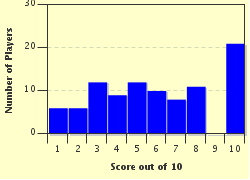Quiz Answer Key and Fun Facts
1. "Baker Street" (1978) by Gerry Rafferty, musician: Raphael Ravenscroft
2. "50 Ways to Leave Your Lover" (1975) by Paul Simon, musician: Steve Gadd
3. "Good Vibrations" (1966) by The Beach Boys, musician: Paul Tanner
4. "Reelin' In the Years" (1972) by Steely Dan, musician: Elliott Randall
5. "Morning Has Broken" (1972) by Cat Stevens, musician: Rick Wakeman
6. "I'm Coming Out" (1980) by Diana Ross, musician: Meco Monardo
7. "For No One" (1966) by The Beatles, musician: Alan Civil
8. "Come On Eileen" (1982) by Dexys Midnight Runners & The Emerald Express, musician: Helen O'Hara
9. "What's Going On" (1971) by Marvin Gaye, musician: James Jamerson
10. "Son of My Father" (1972) by Chicory Tip, musician: Chris Thomas
Source: Author
Upstart3
This quiz was reviewed by FunTrivia editor
1nn1 before going online.
Any errors found in FunTrivia content are routinely corrected through our feedback system.

